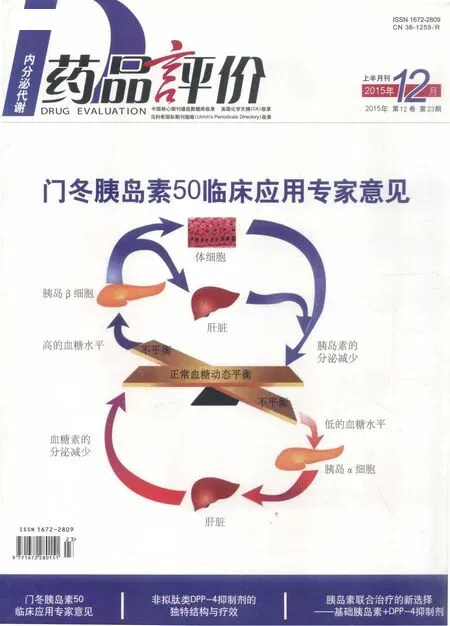全面考量,综合管理 ——DPP-4抑制剂在2型糖尿病治疗中的应用
安徽医科大学第一附属医院内分泌科 王佑民

王佑民 博士,主任医师,教授,硕士和博士生导师。安徽医科大学第一附属医院内分泌科行政副主任、安徽医科大学内分泌代谢病研究所所长、安徽内分泌代谢病省级实验室主任。中国医师协会内分泌代谢科常务委员、中国医师协会内中西医结合专业委员、中华医学会内分泌学会全国委员、安徽省医学会内分泌糖尿病学分会常务委员。《中华内分泌代谢杂志》《中华临床医学杂志》等编委;《药品评价》杂志常务编委。安徽省教育厅中青年骨干教师;安徽省卫生厅跨世纪第一梯队人才,安徽省学术技术带头人。
根据国际糖尿病联盟(International Diabetes Federation,IDF)[1]的最新统计,2013年全球20~79岁成年人的糖尿病患病率为8.3%,患者人数已达3.82亿,预计到2035年,全球糖尿病患者将达到5.92亿。其中,中国的糖尿病患者人数居全球首位。2010年中国成年人糖尿病患病率的调查研究[2]显示,中国成年人群的糖尿病总体患病率估计为11.6%,糖尿病前期患病率已高达50.1%[美国糖尿病学会(American Diabetes Association,ADA)诊断标准];糖尿病患者中只有25.8%接受了治疗,而其中只有39.7%的患者血糖得到了适当控制。由此可见,我国糖尿病的防治未来令人堪忧。
近年来,国内外各权威指南均强调了2型糖尿病(type 2 diabetes mellitus,T2DM)个体化治疗的概念,标志着T2DM个体化治疗时代的到来。最新的血糖控制理念不再以降糖为单一目标,而需综合考虑低血糖、体重增加、心血管风险、肝肾功能、经济成本等多种因素,实现“全面考量,综合管理”。
“全面考量,综合管理”在国内外权威指南中的体现
2012年美国糖尿病学会/欧洲糖尿病研究协会(American Diabetes Association/ European Association for the Study of Diabetes,ADA/EASD)关于2型糖尿病高血糖管理的联合立场声明[3]强调以患者为中心,根据患者需求、偏好和价值制定个体化治疗策略。该声明指出,血糖控制目标和降糖治疗手段必须个体化,应全面考虑患者年龄、体重、性别、种族、遗传差异、合并症(冠状动脉疾病、心力衰竭、慢性肾病、肝功能受损)和低血糖风险等各项因素。降糖药物的安全性非常重要,新药上市前必须经过有足够效能的临床试验证明其有效性和安全性。
2013年美国临床内分泌医师协会(American Association of Clinical Endocrinologists,AACE)综合糖尿病管理路径共识[4]指出,糖化血红蛋白(hemoglobin A1c,HbA1c)目标值应个体化,根据多种因素如年龄、合并症、病程、低血糖风险、预期寿命、患者依从性等进行设定。如能安全达标,HbA1c≤6.5%是优选目标;不同个体状态下,HbA1c>6.5%也可接受。药物的选择必须考虑药物的以下特性:导致低血糖的风险、体重增加的风险、使用便利性、经济成本以及对肾脏、心脏和肝脏功能的影响。
《中国2型糖尿病防治指南(2013年版)》[5]要求针对T2DM患者采用基于循证医学证据的科学、合理的综合性治疗策略,包括降糖、降压、调脂、抗凝、控制体重和改善生活方式等治疗措施。指南明确指出,制订T2DM患者综合调控目标的首要原则是个体化,应该根据患者的年龄、病程、预期寿命、并发症或合并症病情严重程度等进行综合考虑。
DPP-4抑制剂治疗T2DM的有效性
多项DPP-4抑制剂与安慰剂的头对头比较研究[6-14]肯定了DPP-4抑制剂单药治疗的有效性(见表1)。2014年的一项荟萃分析[15]为DPP-4抑制剂单药治疗或与二甲双胍联合治疗T2DM患者的疗效与安全性提供了更新的数据。研究者于MEDLINE、Embase、Cochrane Collaborative database中检索2012年12月之前的为期≥ 12周的随机对照研究,这些研究比较了DPP-4抑制剂单药治疗或与二甲双胍联合治疗T2DM患者的疗效和安全性。关键词包括西格列汀、维格列汀、沙格列汀、阿格列汀、利拉利汀、dutogliptin和二甲双胍,共纳入8项随机对照研究。分析结果显示,与二甲双胍单药治疗相比,DPP-4抑制剂单药治疗带来较小的HbA1c水平降低[MD = 0.28,95%CI 0.17~0.40,P<0.00001]、较小的空腹血糖水平降低[MD = 0.81,95%CI 0.60~1.02,P<0.00001];与二甲双胍单药治疗相比,DPP-4抑制剂联合二甲双胍治疗带来更大的HbA1c水平降低[MD = -0.49,95%CI -0.57~-0.40,P<0.00001]、更大的空腹血糖水平降低[MD = -0.80,95%CI -0.87~-0.74,P<0.00001]。近期的多个系统综述与Meta分析[16-18]都得出相似的结论,DPP-4抑制剂单药治疗可以使患者HbA1c水平降低0.5%~1.0%,效果稍差于二甲双胍,而在二甲双胍单药治疗血糖控制不佳时,加用DPP-4抑制剂可以进一步改善血糖控制。
DPP-4抑制剂治疗T2DM的安全性
我们在关注DPP-4抑制剂有效性的同时应该保证其安全性。DPP-4抑制剂常见的不良反应有恶心/腹痛/腹泻等胃肠道反应、上呼吸道感染、鼻咽炎、头痛;少数还可以有血管性水肿、荨麻疹、皮肤血管炎等过敏性反应;尿路感染、咳嗽、呼吸困难、乏力以及胰腺炎等也偶有报道。

表1 DPP-4抑制剂去除安慰剂效应后的疗效
1. 低血糖风险
低血糖危害严重,因此,在降糖治疗时减少低血糖发生具有重要临床意义,而低血糖风险的评估也成为降糖药物安全性的重要指标。一般认为,DPP-4抑制剂单药治疗的低血糖发生率与安慰剂相似[19]。一项包含西格列汀、沙格列汀、维格列汀、利格列汀的Meta分析[20],纳入了55个西方人群和7个东方人群的随机对照研究。对西方人群的研究结果分析显示,DPP-4抑制剂与安慰剂相比,低血糖风险增加(OR 1.30,95%CI 1.00~1.68)。但对东方人群的研究结果分析显示,DPP-4抑制剂与安慰剂相比,低血糖风险的增加无统计学意义;针对其中17项有阳性药物对照的研究分析显示,DPP-4抑制剂的低血糖风险相较于其他降糖药物无显著差异,DPP-4抑制剂与其他降糖药物联合治疗时也不增加低血糖的发生率。一项随机、双盲、对照研究[21]显示,利格列汀和二甲双胍联用与二甲双胍单药治疗的低血糖发生率相似(1.7% vs 2.4%)。另有一项为期2年的随机、双盲、对照研究[22]显示,在降糖疗效相当的情况下,二甲双胍联用维格列汀组低血糖发生率少于二甲双胍联用格列美脲组(2.3% vs 18.2%)。
2. 体重变化
一项荟萃分析[23]纳入41项为期大于12周的随机对照研究,旨在分析DPP-4抑制剂对T2DM患者的HbA1c、体质指数(body mass index,BMI)的影响。结果显示,与安慰剂相比,DPP-4抑制剂治疗并不增加患者的BMI[+0.2(–0.1~0.6)kg/m2;P=0.11]。另有系统性回顾和荟萃分析[24]显示,DPP-4抑制剂的减重效果弱于二甲双胍,而在二甲双胍基础上联用药物的对比中,DPP-4抑制剂的减重效果显著优于磺脲类药物和吡格列酮,但劣于胰高血糖素样肽-1(glucagon-like peptide-1,GLP-1)受体激动剂。一项24周的随机、平行、对照研究[25]显示,DPP-4抑制剂与胰岛素联合治疗时,没有发生显著的体重变化[(68.6±11.6)kg vs (68.1±11.4)kg],而单用胰岛素的患者体重显著增加[(66.2±10.6)kg vs (67.4±9.7)kg,P<0.05)。
3. 心血管安全性
DPP-4抑制剂的心血管安全性一直备受关注,持续成为ADA的热点之一。目前关于DPP-4抑制剂心血管安全性的大型前瞻性临床研究有SAVOR研究(沙格列汀)[26]、EXAMINE研究(阿格列汀)[27]、TECOS研究(西格列汀)[28]、CAROLINA研究(利格列汀)[29]等。SAVOR-TIMI 53研究[26]结果表明,沙格列汀治疗既不增加也不降低缺血性事件发生率。EXAMINE研究[27]结果表明,在心血管事件风险非常高的患者中,阿格列汀既不增加也不降低心血管发病率和死亡率。这两项研究分别证明了阿格列汀和沙格列汀的心血管安全性,但都只达到了非劣效性终点,未能证实DPP-4抑制剂心血管保护作用的假说。TECOS研究结果在2015年ADA年会上已经公布[28]。该研究显示,西格列汀较安慰剂不会增加任何不良心血管终点事件风险,充分证实了其心血管安全性。正进行的关于的利格列汀CAROLINA研究将会提供更加明确的心血管安全性答案,研究结果预计在2018年发布。该研究旨在比较利格列汀和格列美脲在伴心血管高危风险的2型糖尿病患者中的心血管安全性。
在肝、肾功能不全患者中的应用
各类DPP-4抑制剂的代谢和排泄途径差别很大,所以在肝、肾功能不全患者中的使用也要有所区别。西格列汀主要以原形经尿液排泄,随着肾功能减退,应适当减少用量。维格列汀主要在肾脏代谢为无活性产物并经肾排泄,该过程不依赖CYP 450酶系,所以不受这类酶的影响。沙格列汀主要在肝脏代谢,其活性代谢产物经尿排泄。利格列汀主要通过粪便排出体外,仅5%左右通过肾脏排泄。在肝、肾功能不全的患者中应用DPP-4抑制剂应根据具体情况调整剂量(见表2)。
小 结

表2 各类DPP-4抑制剂在肝肾功能不全的患者中使用
综上所述,DPP-4抑制剂治疗T2DM具有充分的有效性和安全性的临床证据。无论是在饮食和运动方案控制不佳的基础上单药治疗,或是与二甲双胍联合应用,DPP-4抑制剂均能持续有效地降低HbA1c、空腹血糖和餐后血糖,同时不增加体重和低血糖风险,亦不增加心血管风险,有良好的耐受性,为T2DM治疗的综合管理提供了较为理想的药物选择。
[1] The global dominance of diabetes[J]. Lancet, 2013, 382(9906): 1680.
[2] Xu Y, Wang L, He J, et al. Prevalence and control of diabetes in Chinese adults[J]. JAMA, 2013, 310(9): 948-959.
[3] Inzucchi SE, Bergenstal RM, Buse JB, et al. Management of hyperglycaemia in type 2 diabetes: a patient-centered approach. Position statement of the American Diabetes Association(ADA) and the European Association for the Study of Diabetes(EASD)[J]. Diabetologia, 2012, 55(6): 1577-1596.
[4] Garber AJ, Abrahamson MJ, Barzilay JI, et al. American Association of Clinical Endocrinologists' comprehensive diabetes management algorithm 2013 consensus statement[J]. Endocr Pract, 2013, 19(3): 536-557.
[5] 中华医学会糖尿病学分会.2013版中国2型糖尿病防治指南[J].中华糖尿病杂志, 2014, 6(7): 447-498.
[6] Aschner P, Kipnes MS, Lunceford JK, et al. Effect of the dipeptidyl peptidase-4 inhibitor sitagliptin as monotherapy on glycemic control in patients with type 2 diabetes[J]. Diabetes Care, 2006, 29(12): 2632-2637.
[7] Scott R, Wu M, Sanchez M, et al. Efficacy and tolerability of the dipeptidyl peptidase-4 inhibitor sitagliptin as monotherapy over 12 weeks in patients with type 2 diabetes[J]. Int J Clin Pract, 2007, 61(1): 171-180.
[8] Hanefeld M, Herman GA, Wu M, et al. Once-daily sitagliptin, a dipeptidyl peptidase-4 inhibitor, for the treatment of patients with type 2 diabetes[J]. Curr Med Res Opin, 2007, 23(6): 1329-1339.
[9] Nonaka K, Kakikawa T, Sato A, et al. Efficacy and safety of sitagliptin monotherapy in Japanese patients with type 2 diabetes[J]. Diabetes Res Clin Pract, 2008, 79(2): 291-298.
[10] Cai L, Cai Y, Lu ZJ, et al. The efficacy and safety of vildagliptin in patients with type 2 diabetes: a meta-analysis of randomized clinical trials[J]. Clin Pharm Ther, 2012, 37(4): 386-398.
[11] Rosenstock J, Sankoh S, List JF. Glucose-lowering activity of the dipeptidyl peptidase-4 inhibitor saxagliptin in drug-naive patients with type 2 diabetes[J]. Diabetes Obes Metab, 2008, 10(5): 376-386.
[12] Rosenstock J, Aguiler-Salinas C, Klein E, et al. Effect of saxagliptin monotherapy in treatment-nave patients with type 2 diabetes[J]. Curr Med Res Opin, 2009, 25(10): 2401-2411.
[13] Defronzo RA, Fleck PR, Wilson CA, et al. Efcacy and safety of the dipeptidyl peptidase-4 inhibitor alogliptin in patients with type 2 diabetes and inadequate glycemic control: a randomized, double-blind, placebo-controlled study[J]. Diabetes Care, 2008, 31(12): 2315-2317.
[14] Singh-Franco D, McLaughlin-Middlekauff J, Elrod S, et al. The effect of linagliptin on glycaemic control and tolerability in patients with type 2 diabetes mellitus: a systematic review and meta-analysis[J]. Diabetes Obes Metab, 2012, 14(8): 694-708.
[15] Wu D, Li L, Liu C. Efficacy and safety of dipeptidyl peptidase-4 inhibitors and metformin as initial combination therapy and as monotherapy in patients with type 2 diabetes mellitus: a metaanalysis[J]. Diabetes Obes Metab, 2014, 16(1): 30-37.
[16] Karagiannis T, Paschos P, Paletas K, et al. Dipeptidyl peptidase-4 inhibitors for treatment of type 2 diabetes mellitus in the clinical setting: systematic review and meta-analysis[J]. Bri Med J, 2012, 344: e1369.
[17] Giuseppe Derosa, Pamela Maffioli. Dipeptidyl peptidase-4 inhibitors: 3 years of experience[J]. Diabetes Technol Ther, 2012, 14(4): 350-364.
[18] Fass AD, Gershman JA. Efficacy and safety of dipeptidyl peptidase-4 inhibitors in combination with metformin[J]. Adv Ther, 2013, 30(4): 337-353.
[19] Williams-Herman D, Engel SS, Round E, et al. Safety and tolerability of sitagliptin in clinical studies: a pooled analysis of data from 10,246 patients with type 2 diabetes[J]. BMC Endocr Disord, 2010, 10: 7.
[20] Park H, Park C, Kim Y, et al. Efficacy and safety of dipeptidyl peptidase-4 inhibitors in type 2 diabetes: meta-analysis[J]. Ann Pharmacother, 2012, 46(11): 1453-1469.
[21] Haak T, Meinicke T, Jones R, et al. Initial combination of linagliptin and metformin improves glycaemic control in type 2 diabetes: a randomized, doubleblind, placebo-controlled study[J]. Diabetes Obes Metab, 2012, 14(6): 565-574.
[22] Matthews DR, Dejager S, Ahren B, et al. Vildagliptin add-on to metformin produces similar efficacy and reduced hypoglycaemic risk compared with glimepiride, with no weight gain: results from a 2-year study[J]. Diabetes Obes Metab, 2010, 12(9): 780-789.
[23] Monami M, Iacomelli I, Marchionni N, et al. Dipeptydil peptidase-4 inhibitors in type 2 diabetes: a meta-analysis of randomized clinical trials[J]. Nutr Metab Cardiovasc Dis, 2010, 20(4): 224-235.
[24] Karagiannis T, Paschos P, Paletas K, et al. Dipeptidyl peptidase-4 inhibitors for treatment of type 2 diabetes mellitus in the clinical setting: systematic review and meta-analysis[J]. Bri Med J, 2012, 344: e1369.
[25] Hong ES, Khang AR, Yoon JW. Comparison between sitagliptin as addon therapy to insulin and insulin dose-increase therapy in uncontrolled Korean type 2 diabetes: CSI study[J]. Diabetes Obes Metab, 2012, 14(9): 795-802.
[26] Scirica BM, Bhatt DL, Braunwald E, et al. Saxagliptin and cardiovascular outcomes in patients with type 2 diabetes mellitus[J]. N Engl J Med, 2013, 369(14): 1317-1326.
[27] White WB, Cannon CP, Heller SR, et al. Alogliptin after acute coronary syndrome in patients with type 2 diabetes[J]. N Engl J Med, 2013, 369(14): 1327-1335.
[28] Green JB, Bethel MA, Armstrong PW, et al. Effect of sitagliptin on cardiovascular outcomes in type 2 diabetes[J]. N Engl J Med, 2015, 373(3): 232-242.
[29] CAROLINA: Cardiovascular Outcome Study of linagliptin versus glimepiride in patients with type 2 diabetes NLMIdentifier: NCT01243424.

